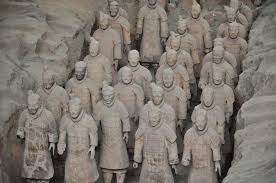
Why Was the Terracotta Army Made?
The Terracotta Army, a vast collection of life-sized terracotta sculptures depicting warriors and horses, is one of the most iconic archaeological discoveries of all time. Standing guard over the tomb of Qin Shi Huang, the first emperor of China, for over two millennia, these figures offer a fascinating glimpse into the ancient Chinese beliefs surrounding death and the afterlife.
A Reflection of Ancient Beliefs: The Realms of the Living and the Dead
To understand the purpose of the Terracotta Army, we must first delve into the ancient Chinese worldview. The Chinese believed in a parallel existence of two realms: the Yang, representing the world of the living, and the Yin, representing the world of the dead. Death was not seen as an end but as a transition to this other realm.
Crucially, the ancient Chinese believed that life in the Yin realm mirrored that of the Yang. Just as an emperor needed armies, servants, and opulent palaces in life, he would require the same in death. This belief, known as "视死如生" (shì sǐ rú shēng) – to view death as life – forms the very foundation of why Qin Shi Huang commissioned the creation of the Terracotta Army.
An Army for Eternity: Safeguarding the Emperor in the Afterlife
Qin Shi Huang, known for his ambition and desire for immortality, unified China through conquest and ruled with an iron fist. His vision extended beyond his earthly life; he sought to rule in the afterlife with the same authority and power. He believed that by surrounding his tomb with an army, he could ensure his continued dominance and protection in the Yin realm.
The sheer scale of the Terracotta Army speaks volumes about the importance placed on this belief. Thousands upon thousands of meticulously crafted soldiers, each with unique features and weapons, were positioned in battle formation, ready to answer the emperor's call even in death.
Immortalizing Valor: The Faces of Qin's Warriors
Each terracotta warrior is unique, sculpted with incredible detail and individuality. The variations in facial features, hairstyles, armor, and weapons suggest that the artisans may have modeled the figures after real soldiers in Qin Shi Huang's army. This meticulous attention to detail suggests a desire to not only create an army for the afterlife but to immortalize the bravery and dedication of the soldiers who served the Qin empire.
The Terracotta Army, therefore, serves as a testament to the might of the Qin military and the unwavering loyalty of its soldiers. It is a powerful symbol of the emperor's ambition, the beliefs of a bygone era, and the artistry of ancient Chinese craftsmen.
Questions & Answers
Q1: What is the significance of the Terracotta Army's unique features?
A1: The individual features suggest the figures were modeled after real soldiers, highlighting the value placed on individual bravery and the desire to honor these warriors in the afterlife.
Q2: How does the Terracotta Army reflect the concept of "视死如生" (shì sǐ rú shēng)?
A2: The army's creation exemplifies "viewing death as life" as it aimed to provide the emperor with the same military might and protection in the afterlife as he commanded in life.
Q3: What does the Terracotta Army reveal about Qin Shi Huang's personality and ambitions?
A3: The army's scale and grandeur reflect Qin Shi Huang's immense power, his desire for immortality, and his ambition to rule with absolute authority even in the afterlife.